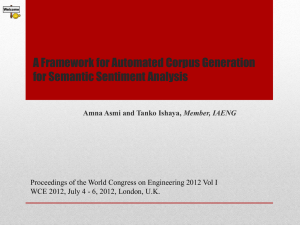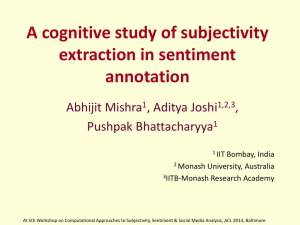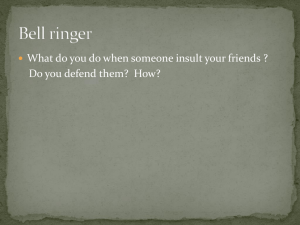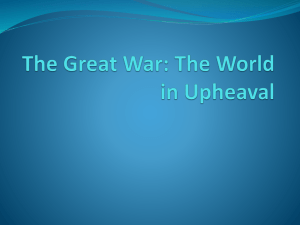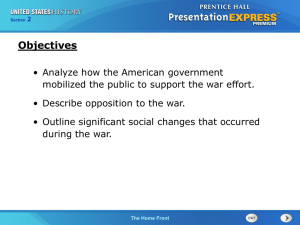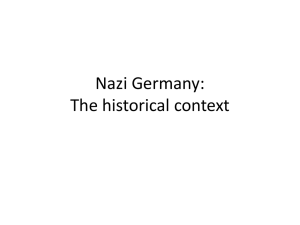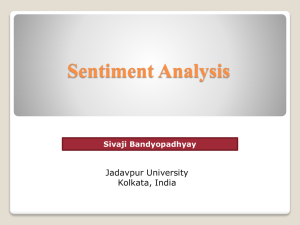GermanPolarityClues
advertisement
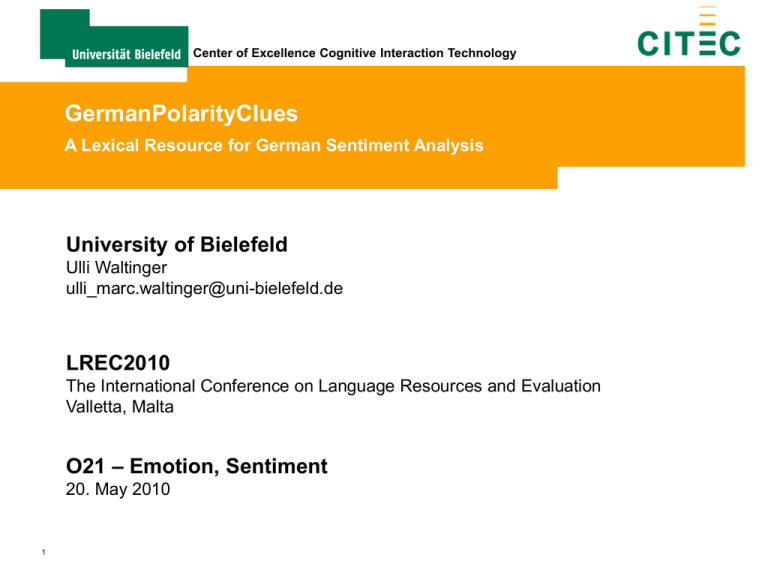
Center of Excellence Cognitive Interaction Technology GermanPolarityClues A Lexical Resource for German Sentiment Analysis University of Bielefeld Ulli Waltinger ulli_marc.waltinger@uni-bielefeld.de LREC2010 The International Conference on Language Resources and Evaluation Valletta, Malta O21 – Emotion, Sentiment 20. May 2010 1 Center of Excellence Cognitive Interaction Technology GermanPolarityClues A Lexical Resource for German Sentiment Analysis • Agenda • Introduction • Related Work • Sentiment Resources • Study Overview • Experiments - English / German • Results • Conclusion 2 Center of Excellence Cognitive Interaction Technology GermanPolarityClues A Lexical Resource for German Sentiment Analysis • Introduction: • Sentiment analysis - a discipline of information retrieval – the opinion mining (OM) • OM analyzes the characteristics of opinions, feelings and emotions that are expressed in textual (Pang et al., 2002) or spoken (Becker-Asano and Wachsmuth, 2009) data with respect to a certain subject. • Subtask of sentiment analysis - categorization on the basis of certain polarities - the sentiment polarity identification (Pang et al.,2002) 3 Center of Excellence Cognitive Interaction Technology GermanPolarityClues A Lexical Resource for German Sentiment Analysis • Introduction: • Polarity Identification focuses on the classification of positive, negative or neutral expressions in texts. • Polarity-related term feature interpretation, most of the proposed methods make use of manually annotated or automatically constructed lists of polarity terms. • English language: Only a small number are freely available to the public. • German language: Currently no annotated dictionary freely available. 4 Center of Excellence Cognitive Interaction Technology GermanPolarityClues A Lexical Resource for German Sentiment Analysis • Introduction • Determination of polarity-features is in the center in order to draw conclusions of polarity-related orientation of the entire text. “Wonderful when it works... I owned this TV for a month. At first I thought it was terrific. Beautiful clear picture and good sound for such a small TV. Like others, however, I found that it did not always retain the programmed stations and then had to be reprogrammed every time you turned it off. I called the manufacturer and they admitted this is a problem with the TV.” 5 Center of Excellence Cognitive Interaction Technology GermanPolarityClues A Lexical Resource for German Sentiment Analysis • Introduction: • Problem - text categorization approaches (e.g. bag-of-words) need to be extended or seized to the domain of sentiment analysis • Proposed (semi-) supervised sentiment-related approaches make use of annotated and constructed lists of subjectivity terms. • Coverage rate, the number of comprised subjectivity terms varies significantly - ranging between 8,000 and 140,000 features. 6 Center of Excellence Cognitive Interaction Technology GermanPolarityClues A Lexical Resource for German Sentiment Analysis • Research Questions: • How does the significant coverage variations of the English sentiment resources correlate to the task of polarity identification? • Are there notable differences in the accuracy performance, if those resources are used within the same experimental setup? • How does sentiment term selection combined with machine learning methods affect the performance? • Are we able to draw conclusions from the results of the experiments in building a German sentiment analysis resource? 7 Center of Excellence Cognitive Interaction Technology GermanPolarityClues A Lexical Resource for German Sentiment Analysis • Related Work: • Turney and Littman (2002): Counting positive and negative terms. • Machine-learning approaches (Turney, 2001) on different document levels • entire documents (Pang et al. (2002)) • phrases (Wilson et al., 2005; Agarwal et al., 2009) • sentences (Pang and Lee, 2004) • Kennedy and Inkpen (2006): Discourse-based contextual valence shifters. 8 Center of Excellence Cognitive Interaction Technology GermanPolarityClues A Lexical Resource for German Sentiment Analysis • Related Work: • Chaovalit and Zhou (2005): Comparative study on supervised and unsupervised classification methods. Machine learning on the basis of SVM are more accurate than any other unsupervised classification approaches. •Tan and Zhang (2008): Empirical study on feature selection (e.g. chi square, subjectivity terms) and learning methods (e.g. kNN, NB, SVM) on a Chinese data set. Combination of sentimental feature selection and machine learning-based SVM performs best. 9 • Prabowo and Thelwall (2009): Combined approach using rulebased, supervised and machine learning methods. No single classifier outperforms the other. Center of Excellence Cognitive Interaction Technology GermanPolarityClues A Lexical Resource for German Sentiment Analysis • Related Work: • In general, sentence-based polarity identification contributes to a higher accuracy performance, but induces also a higher computational complexity. • Reported increase of accuracy of document and sentence classifier range between 2 - 10% (Pang and Lee, 2004; Wiegand and Klakow, ) mostly compared to the baseline (e.g. Naive Bayes). • At the focus of almost all approaches, a set of subjectivity terms is needed, either to train a classifier or to extract polarity-related terms following a bootstrapping strategy (Yu and Hatzivassiloglou, 2003). 10 Center of Excellence Cognitive Interaction Technology GermanPolarityClues A Lexical Resource for German Sentiment Analysis • Subjectivity Dictionaries: • Hatzivassiloglou et al. (1997) - Adjective Conjunctions: Bootstrapping approach on the basis of adjective conjunctions. Small set of manually annotated seed words (1,336 adjectives), used in order to extract a number of 13,426 conjunctions, holding the same semantic orientation. • Maarten et al. (2004) - WordNet Distance: Measuring the semantic orientation of adjectives on the basis of the linguistic resource WordNet (Fellbaum, 1998). 11 • Strapparava and Valitutti (2004) - WordNet-Affect: Synset-relations of WordNet with respect to their semantic orientation. Dataset comprises 2,874 synsets and 4,787 words Center of Excellence Cognitive Interaction Technology GermanPolarityClues A Lexical Resource for German Sentiment Analysis • Subjectivity Dictionaries: • Wiebe et al. (2005) - Subjectivity Clues: Most fine-grained polarity resource. In total, 8,221 term features rated by their polarity (+,-) but also by their reliability (e.g. strongly subjective, weakly subjective) • Takamura et al. (2005) - SentiSpin: Extracting the semantic orientation of words using the Ising Spin Model. Dataset offers a number of 88,015 words for the English language. 12 • Esuli and Sebastiani (2006) - SentiWordNet: Analysis of glosses associated to synsets of the WordNet data set. Dataset comprises 144,308 terms with polarity scores assigned. Center of Excellence Cognitive Interaction Technology GermanPolarityClues A Lexical Resource for German Sentiment Analysis • Experiments: • Focus is set on the most widely used and freely available subjectivity dictionaries for the task of sentiment-based feature selection. • Subjectivity Clues (Wiebe et al., 2005) • SentiSpin (Takamura et al., 2005) • SentiWordNet (Esuli and Sebastiani, 2006) • Polarity Enhancement (Waltinger, 2009) • Evaluating polarity classification is a document-based hard-partition machine learning classifier (Pang et al., 2002) using SVM. 13 Center of Excellence Cognitive Interaction Technology GermanPolarityClues A Lexical Resource for German Sentiment Analysis • Evaluation Corpus (English): • Polarity identification classification using the movie review corpus initially compiled by (Pang et al.,2002) • Two polarity categories (positive and negative), each category comprises 1000 articles with an average of 707.64 textual features • Using Leave-One-Out cross-validation, reporting F1-Measure as the harmonic mean between Precision and Recall. 14 Center of Excellence Cognitive Interaction Technology GermanPolarityClues A Lexical Resource for German Sentiment Analysis • German Subjectivity Dictionary: • Majority of subjectivity resources are based on the English language • Translated the two most comprehensive dictionaries, the Subjectivity Clues (Wiebe et al., 2005) and the SentiSpin (Takamura et al., 2005) dictionary into the German language by automatic means (top3). (English: ”brave”—”positive” -- German: ”mutig”—”positive”) • Compiled the GermanPolarityClues dictionary, (resolve ambiguity) by manually assessing individual term features of the dataset by their sentiment orientation • Added additional negation-phrases and the most frequent positive and negative synonyms of existing term features (Wiktionary) 15 Center of Excellence Cognitive Interaction Technology GermanPolarityClues A Lexical Resource for German Sentiment Analysis • German Subjectivity Dictionary: • Overview of the data schema by (A) automatic- and (B) corpus-based polarity orientation rating Id: Feature PoS A(+) A(-) A(o) B(+) B(-) B(o) 5653 Begündung NN 0 0 1 0 0.5 0.5 7573 Katastrophe NN 0 1 0 0 0.68 0.32 7074 ideal ADJD 1 0 0 0.76 0.13 0.11 GPC-Overall Features: No. Positive Features: No. Negative Features: No. Neutral Features: 16 10,141 3,220 5,848 1,073 German SentiSpin: German Subjectivity: German Polarity Clues: 10,802 2,657 2,700 Center of Excellence Cognitive Interaction Technology GermanPolarityClues A Lexical Resource for German Sentiment Analysis • Evaluation Corpus (German): • Manually created a reference corpus by extracting review data from the Amazon.com website • Human-rated product reviews with an attached rating scale from 1 (worst) to 5 (best) stars. • 1000 reviews for each of the 5 ratings, each comprising 5 different categories. 17 Center of Excellence Cognitive Interaction Technology GermanPolarityClues A Lexical Resource for German Sentiment Analysis • Resource Overview : The standard deviation and arithmetic mean of subjectivity features by resource, text corpus and polarity category. Resource: Subject. Clues Senti Spin No. of Features: 6,663 88,015 144,308 137,088 105,561 9,827 10,141 Positive-AMean: 76.83 236.94 241.36 239.25 53.63 27.70 26.66 Positive-StdDevi: 30.81 84.29 85.61 84.98 6.90 4.59 5.01 Negative-AMean: 69.72 218.46 223.11 221.25 50.18 25.68 24.14 Negative-StdDevi: 26.22 74.08 75.37 74.68 10.40 5.88 5.41 Text-AMean: 707.64 707.64 707.64 707.64 109.75 109.75 109.75 Text-StdDevi: 296.94 296.94 296.94 296.94 24.52 24.52 24.52 18 Senti Polarity German German German WordNet Enhance SentiSpin Subject. Polarity Clues Center of Excellence Cognitive Interaction Technology GermanPolarityClues A Lexical Resource for German Sentiment Analysis • Results English: Accuracy results comparing four subjectivity resources and four baseline Sentiment-Method Naive Bayes -unigrams (Pang et al., 2002) Maximum Entropy -top 2633 unigrams (Pang et al., 2002) SVM -unigrams+bigrams (Pang et al., 2002) SVM -unigrams (Pang et al., 2002) Polarity Enhancement -PDC (Waltinger, 2009) 19 Subjectivity-Clues SVM Linear-Kernel Subjectivity-Clues SVM RBF-Kernel SentiWordNet SVM Linear-Kernel SentiWordNet SVM RBF-Kernel SentiSpin SVM Linear-Kernel SentiSpin SVM RBF-Kernel Accuracy 78.7 81.0 82.7 82.9 83.1 84.1 83.5 83.9 82.3 83.8 82.5 Center of Excellence Cognitive Interaction Technology GermanPolarityClues A Lexical Resource for German Sentiment Analysis • Results - English • F1-Measure evaluation results of an English subjectivity feature selection using SVM. Resource English Subjectivity Clues English SentiWordNet English SentiSpin English Polarity Enhancement 20 Model SVM-Linear SVM-RBF SVM-Linear SVM-RBF SVM-Linear SVM-RBF SVM-Linear F1-Positive .832 .828 .832 .816 .831 .815 .841 F1-Negative .823 .823 .828 .812 .827 .811 .837 F1-Average .828 .826 .830 .814 .829 .813 .839 Center of Excellence Cognitive Interaction Technology GermanPolarityClues A Lexical Resource for German Sentiment Analysis • Results German Resource Model German SentiSpin Star12 vs. Star45 SVM-Linear SVM-RBF SVM-Linear SVM-RBF SVM-Linear SVM-RBF SVM-Linear SVM-RBF SVM-Linear SVM-RBF SVM-Linear SVM-RBF German SentiSpin Star1 vs. Star5 German Subjectivity Star12 vs. Star45 German Subjectivity Star1 vs. Star5 GermanPolarityClues Star12 vs. Star45 GermanPolarityClues Star1 vs. Star5 21 F1Positive .827 .830 .857 .855 .810 .804 .841 .834 .875 .866 .875 .855 F1Negative .828 .830 .861 .858 .813 .803 .842 .834 .730 .661 .876 .850 F1Average .828 .830 .859 .857 .811 .803 .841 .834 .803 .758 .876 .853 Center of Excellence Cognitive Interaction Technology GermanPolarityClues A Lexical Resource for German Sentiment Analysis • Results: • English-based baseline experiments indicate, that the smallest resource, Subjectivity Clues, perform with a touch better than SentiWordNet, SentiSpin and the Polarity Enhancement dataset (F1-Measure results between 82.9 - 83.9). • Subjectivity feature selection in combination with machine learning classifier clearly outperform the well known baseline results as published by Pang et al., 2002 (NB: acc = 78.7; ME: acc = 81.0; N-Gram-based SVM: acc = 82.9). 22 • Size of the dictionary clearly correlates to the coverage (arithmetic mean of polarity-features selected varies between 76.83 241.36) but not to accuracy. Center of Excellence Cognitive Interaction Technology GermanPolarityClues A Lexical Resource for German Sentiment Analysis • Results: • Newly build German subjectivity resources, used for the document-based polarity identification, indicate similar perceptions. • German SentiSpin version, comprising 105,561 polarity features, lets us gain a promising F1-Measure of 85.9. • The German Subjectivity Clues, comprising 9,827 polarity features, performs with an F1-Measure of 84.1 almost at the same level. • The German Polarity Clues dictionary, comprising 10,141 polarity features, outperforms with an F1-Measure of 87.6 all other resources. 23 Center of Excellence Cognitive Interaction Technology GermanPolarityClues A Lexical Resource for German Sentiment Analysis • Resource • The constructed resources can be freely accessed and downloaded: http://hudesktop.hucompute.org/ 24 Center of Excellence Cognitive Interaction Technology GermanPolarityClues A Lexical Resource for German Sentiment Analysis University of Bielefeld Ulli Waltinger ulli_marc.waltinger@uni-bielefeld.de LREC2010 The International Conference on Language Resources and Evaluation Valletta, Malta O21 – Emotion, Sentiment 20. May 2010 25
